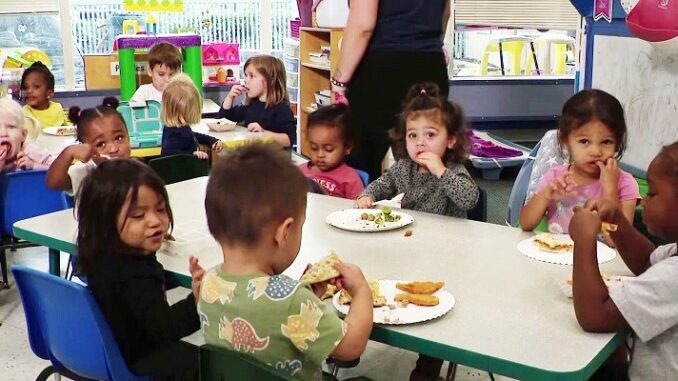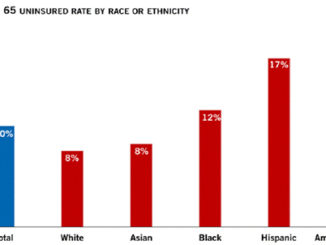
The “child care cliff” marks the end of one of the last pandemic-era safety nets.
This weekend, parents and child care providers across the nation are bracing for the end of an instrumental federal program that has stabilized child care programs and reduced costs for families over the past three years.
Some $24 billion worth of child care funding — one of the last remaining Covid-19 emergency relief programs still in effect — is set to expire Saturday. Issued as part of the $1.9 trillion American Rescue Plan, the program marked the largest investment in child care in US history and allowed fragile businesses to cover rent and maintenance and raise wages for their notoriously underpaid staff. The Biden administration has reported that the grants helped 80 percent of US licensed child care centers stay afloat.
Frequently referred to as the “child care cliff,” the expiration of the grants is expected to renew strain on the child care sector, which already runs on tight margins, struggles to recruit and retain staff from higher-paying industries, and charges most parents far more than they can comfortably afford.
Many news organizations, including the New York Times, the Washington Post, Axios, Bloomberg, the Wall Street Journal, and MSNBC, have cited an estimate from the liberal think tank the Century Foundation stating that 70,000 child care programs will likely close, resulting in 3.2 million children losing access to care.
That figure was derived from an October 2022 survey of 12,000 early childhood educators that found 34 percent of child care programs reported that they would have closed during the pandemic if not for the emergency grants. The grants covered 220,000 programs and 9.6 million kids, so the Century Foundation multiplied those figures by 0.34 to arrive at its estimate.
Experts in child care policy told Vox, however, that the “cliff” may prove far less of a tumble for providers and families than that popular statistic suggests — partly due to poor data on industry supply and demand and partly because most states have made unprecedented investments in their child care systems over the last two years.
The federal grants were authorized to help child care programs during the extraordinary circumstances of the pandemic, after lawmakers deemed the child care sector “uniquely vulnerable” to the crisis, and less able to access relief loans through methods available to other small businesses. In a US Senate HELP Committee report issued this past spring, Sens. Bernie Sanders (I-VT) and Patty Murray (D-WA) noted that emergency relief was needed because child care providers began “hemorrhaging money during pandemic shutdowns” as fewer children attended and they faced unexpected costs to comply with reduced group sizes, cleaning materials, and personal protective equipment.
Today, programs are no longer struggling to enroll students nor needing to cover the costs of pandemic safety regulations. “Saying you would have closed during Covid if not for the grants is not the same thing, that you will close after Covid if the grants don’t continue,” said Matt Bruenig, founder of another left-wing think tank, the People’s Policy Project.
One leading child care expert declined to comment on the widely cited Century Foundation estimate (“We didn’t do the number and I don’t want to speak directly to that,” Sarah Rittling, of the First Five Years Fund, told Vox), while another said that they knew no one who expected the loss of programs to reach anywhere near 70,000, but did not want to say so on the record for fear of alienating other leaders in their child care advocacy coalition.
“Will there be some adjustments [when the funds expire]? Yes, obviously, that’s fairly true, but you see estimates that a quarter of American kids will lose their child care spots and I will gladly take any bet that anyone at the Century Foundation wants to place,” said Patrick T. Brown, a child care policy analyst at the Ethics and Public Policy Center, a conservative think tank. “I do not think 25 percent of kids are going to lose their child care. People have a vested interest in using strong frames and narratives to say we have a broken market.”
Julie Kashen, director for women’s economic justice at The Century Foundation, defended her organization’s analysis but acknowledged that the estimate of program closures is unlikely to come to pass, telling Vox it’s more like a “worst-case scenario.”
“A number of states have put forward their own state funding and our analysis did not account for that,” she said. “We don’t have numbers yet of how much will be mitigated by state investments, but from Alaska to Maine to Illinois, they have put their own funding in, and that will make a decent difference in reducing the losses.”
Why Congress isn’t extending the Covid-19 child care grants
The federal pandemic grants were objectively successful in helping to stabilize the child care sector over the last three years, leaving many people baffled that Congress would choose not to renew the funding now. The Department of Labor recently reported that the price of child care rose 6 percent in July over the previous year, nearly double the rate of inflation.
From Republicans’ perspective, the child care grants, like other Covid-19 safety net programs, were passed as an emergency relief measure, and now that the emergency is over, the pandemic level of spending should not become the new federal baseline. A strong current among conservatives supports “going back to normal” and reining in spending more broadly to address inflation and the deficit.
Democrats and progressives argue that funding for child care was woefully low before the pandemic, and returning to the status quo now, amid a tighter labor market and fierce hiring competition from other industries, would be untenable. Reduced federal funding could mean pay cuts or hiring freezes, or hikes in costs that families can’t afford, leading to fewer children served and, ultimately, closure of some programs.
In response to the impending deadline, congressional Democrats earlier this month proposed a bill to give $16 billion to child care providers each year for the next five years. It has no Republican co-sponsors and even its own authors concede that it’s unlikely to go anywhere. The Biden administration has declined to lobby for additional child care funding in the fraught ongoing budget negotiations, arguing that it needs to bargain with Republicans only over emergency priorities to stave off a government shutdown.
One recurring challenge for Democrats is that because they have so many areas they want to see new big investments in, and because they work within broad advocacy coalitions, leaders often struggle to home in on a few specific priorities, instead championing lots of big social investments at once.
This dynamic was on display during the failed Build Back Better negotiations and amid Inflation Reduction Act talks. Child care investments were in competition with new spending on preschool, affordable housing, paid medical and family leave, and the expanded child tax credit. In the end, virtually none won out.
Child care programs face tougher staff recruitment. Parents face higher costs.
Over the last two years many states passed new legislation to support child care access, affordability, and quality, including red states such as Alabama, Louisiana, Montana and North Dakota, as well as blue and purple states like Minnesota, New Mexico, New Hampshire, Illinois, California, Alaska and Vermont. Most states were in strong fiscal positions and built on the political momentum for child care investments that coalesced during the pandemic.
Linda Smith, who heads early childhood research at the Bipartisan Policy Center, told Vox that the impact of the expiring pandemic funds will vary by state, but she expects that broadly, retaining child care workers will become harder. In 2019, the median child care worker earned $11.65 per hour. Today their pay averages $14.22, but without public subsidy, programs may have to raise rates for families to continue paying workers those higher wages. The survey released last October and cited by the Century Foundation found that 43 percent of child care centers and 37 percent of home-based providers expected that they’d have to raise rates when federal relief dollars dry up.
“In lower-income working families, passing those costs on to parents is not going to be an option,” said Smith. These increased costs will also overlap with the resumption of student loan payments in October after a three-year pause, and higher interest rates on credit cards, mortgages, and car loans.
Some states are already starting to see the effects of diminished funding. In June, the Republican-controlled legislature in Wisconsin started reducing its federal stabilization grants from $20 million a month to $10 million, and the remaining funds are expected to end completely in January. Ruth Schmidt, the executive director of the Wisconsin Early Childhood Association, told CBS that nearly 90 percent of day care centers are raising tuition in response. Some programs have closed.
Whitney Evans, the California director for ParentChild+, said she expects the decline in federal funding will affect low-income parents who are least able to work remotely. “For middle-income families, this is going to be a huge pain in the ass but they’ll figure out a way,” she told Vox. “But for children with the least access to resources, who won’t be able to pay more for slots if rates go up, there will be even less space available.”
Could this affect female workforce participation?
A big question looming over the expiring child care funds is whether a major disruption to the child care ecosystem would force parents — and mothers in particular — out of their jobs. Child care advocates have been saying for years that a failure to invest more in the nation’s child care system will result in that outcome; this was a key argument during the fight for the Build Back Better Act.
However, despite the failure of Congress to pass those new child care investments, workforce participation among moms, and even moms of very young children, has continued to rise. The latest data showed 66.6 percent of women who gave birth in the previous 12 months were working in 2022, up from 66.5 percent in 2021, and 61.6 percent in 2010. And more than 70 percent of mothers with kids under five were working this past summer — more than even before the pandemic. The expansion of remote work, which makes it easier for parents to juggle their jobs and child care responsibilities, is likely one major contributing factor.
Kashen, of the Century Foundation, credits the American Rescue Plan investments for staving off female workforce fallout, and said that the “reality is most parents have to work,” so even if moms are employed, it doesn’t mean they aren’t making hard trade-offs behind the scenes, including working later hours, facing declining mental and physical health, or spending less time with family.
Is there any chance child care funding will return?
The politics are challenging right now. Congressional Republicans are currently engaged in a fierce battle over cutting federal spending and have expressed little appetite for new social investments.
Still, the news isn’t all bad. Among parents, the child care issue is far less polarized. A recent poll of Kentucky voters and parents found strong support for investing more taxpayer money into child care programs, and a national poll conducted for the First Five Years Fund this summer found that 74 percent of voters, including 61 percent of Republican voters, back increased federal spending for child care.
Moreover, during the second Republican presidential debate earlier this week, the moderators pressed candidates on how they would expand access to care — even citing the expiring pandemic-era funds. South Carolina Sen. Tim Scott blasted the Biden administration for allowing day care costs to exceed $15,000 per child, and Doug Burgum, the GOP governor of North Dakota, stressed that “child care is workforce infrastructure.”
That bipartisan support for affordable child care is likely why Republicans, after rebuffing Democrats’ $400 billion child care proposal during the Build Back Better fight, agreed to a 30 percent increase last year of the Child Care and Development Block Grant, a federal program aimed at reducing child care costs for low-income families. And this past summer, Reps. Ro Khanna (D-CA) and Nancy Mace (R-SC) announced the launch of a new Bipartisan Affordable Childcare Caucus in Congress, and Reps. Salud Carbajal (D-CA) and Lori Chavez-DeRemer (R-OR) introduced a bipartisan bill to improve federal child care tax credits, legislation endorsed by advocacy groups and the US Chamber of Commerce.
Some Republican lawmakers remain ideologically against government involvement in child-rearing and oppose efforts such as increased spending on non-religious day care centers. This is partly why some Republicans are more open to expanding the federal child tax credit, which gives money directly to families to spend how they see fit. Expanding the tax credit is also a priority for Democrats, though it might be tough for lawmakers to secure new investments for child care and the child tax credit at the same time.
Progressives, for their part, are hopeful that they’ll have another opportunity to push new child care investments during the end-of-the-year omnibus tax package negotiations. Last year advocates secured new funding in this period for a maternal and child health home visiting program, doubling the amount of federal spending and reauthorizing the program for five years.
“The pandemic gave us all a better sense of what it means to have more money in the child care system,” said Rittling, of the First Five Years Fund. “We know that money needs to be sustained beyond Covid, and we’ll be looking at every possible way we can to make that happen.”
.
Rachel M. Cohen is a senior reporter for Vox covering social policy. She focuses on housing, schools, labor, criminal justice, and abortion rights, and has been reporting on these issues for more than a decade.



